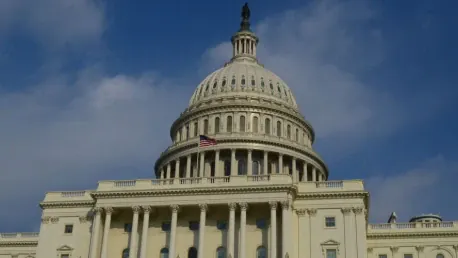Listen to the Article
In a tense ending fitting for what has been a dramatic year for US politics and government. From a campaign trail that brought several twists and turns, to a red sweep at the polls – a Republican victory across the board.
As the year comes to a close, the government must find a resolution to the budget by December 21, in order to avoid a furlough of 3 million federal workers. With the holidays within sight, a government shutdown would be tantamount to chaos, as critical services and operations would be severely impacted.
With federal funding set to expire at 12:01 a.m., many are wondering how this situation could impact critical services and government operations – especially with the holidays right around the corner.
What is Behind the Potential Shutdown?
At midnight on December 20, the government’s spending bill will officially expire. If Congress cannot agree and pass a new budget, then government spending will cease, leaving millions of federal workers in uncertainty regarding pay. With the holidays around the corner, this adds tension to the role lawmakers play in passing the Bill, as several government operations may be impacted, with far-reaching effects for the American people as well.
Legislators will need to agree on a bill that makes provisions for funding for the period of December 21 to March 14. With many dissenting voices, Speaker of the House, Mike Johnson pulled the bill to allow representatives to debate further. Some of the louder voices have come from President-elect Donald Trump and his ally, Elon Musk.
While this represents a major challenge, Speaker Johnson remained confident that the matter will be resolved. Legislators are working to revise the bill, and representatives from across the aisle are scheduled to meet to make the necessary revisions. Finding a solution is critical to avoiding furloughing federal employees and keeping government operations running smoothly.
What Happens During a Shutdown?
During a government shutdown, federal departments need to operate with fewer resources. This often results in reduced hours, scaled-back services, and fewer employees. Typically, agencies that are deemed “non-essential” go on a pause, and workers are furloughed, while essential services (law enforcement, air traffic control, etc.) continue at this reduced pace. Unfortunately, essential service providers are expected to work without compensation. The financial strain this places on employees cannot be ignored.
The shutdown in 2018 lasted over a month, and had a devastating effect on low-income workers. Close to 800,000 federal employees were affected and forced to rely on food banks and other charitable efforts. For non-essential workers living paycheck to paycheck, bills were covered with personal loans, which took months to financially recover from.
Will Beneficiaries Have Access to Medicare and Social Security?
Approximately 70.2 million Americans rely on government assistance in the form of Social Security. While the prospect of a federal shutdown may cause concern for beneficiaries, legislation dictates that it would be business as usual. Government social services draw their funding from a differently legislated approval process, and would remain unaffected.
Seniors, veterans, and retirees can rest assured that their Social Security and Medicare benefits will continue as usual. What may pose a challenge, however, is the administrative services. People applying for benefits may have to wait until after the shutdown for processing and verification.
Will Air Travel Be Affected?
The Transportation Security Administration (TSA) is a federal agency, which raises questions about how air travel will be impacted in the event of a shutdown. Air traffic controllers and TSA agents are classified as essential workers and will be mandated to continue working, despite not receiving pay.
According to the TSA, they are expecting a record 40 million passengers to pass through their lines. At most, travelers should brace themselves for long lines and are advised to factor this into their travel time, and exercise patience.
What About Military Pay and Operations?
When it comes to the military, there are two different responses. Active-duty military members and federal law enforcement agencies will continue to work, and can expect delays in payment. If the shutdown does occur, there may also be additional questions raised regarding the scheduled 4.5% pay increase for military members. Employees of the Department of Defense who work at the civilian level may be furloughed.
Broader Impacts on Business and Daily Life
A government shutdown would certainly impede daily life for millions of citizens, as services will slow down. Administrative tasks, in particular, will be impacted, like passport processing, granting small business loans, and food inspections. Visitors hoping to use the holidays to visit National Parks may be disappointed, and the Internal Revenue Service (IRS) will need additional time after the shutdown to catch up on the backlog a shutdown would create. Experts caution, however, against delaying submissions as deadlines for taxes will remain in place.
How Can Congress Avoid a Shutdown?
Congress has before them two viable paths to resolve the funding issue; they either need to pass appropriations or a continuing resolution (CR). The idea behind the first option is for the various House and Senate Appropriations Committees to pass 12 different appropriation bills. These are broken into sub-committees based on subject matter and funding levels, and come together as an “omnibus” legislation.
Avoiding a shutdown would require all 12 appropriations bills to be drafted, passed by both the Senate and the House, and then signed by the President. Legislators can either package the bills into the omnibus legislation, or opt to follow the process for each bill individually.
The second option available to Congress is the passing of a continuing resolution, which would allow them to continue funding federal activities based on the 2024 financial year.
What is a Continuing Resolution?
A continuing resolution provides a contingency option for the government to temporarily fund the government in the absence of full appropriations bills. Typically, this involves continuing funding levels from the prior year.
CRs provide legislators with some breathing room; federal operations can continue while appropriations bills follow the approval process. However, these resolutions are not a silver bullet and only apply to certain appropriations.
How Often Does Congress Pass Crs?
Continuing resolutions are utilized fairly often as a tool to assist Congress when legislators are unable to reach a resolution in time to meet a deadline. In some instances, more than one CR is tabled to make contingencies last an entire financial year, so it’s not difficult to imagine that Congress could use this tool to avoid a shutdown.
Conclusion
A government shutdown can create plenty of challenges, from furloughed workers to delayed services. But businesses and individuals alike can take comfort in knowing that essential functions – like Social Security payments and law enforcement – will keep running.
As Congress works to find a resolution, the focus remains on minimizing disruptions for everyone involved. Whether it’s air travel, small business operations, or federal worker paychecks, most analysts expect a solution to emerge before the shutdown’s effects are fully felt.
Keep an eye on developments, and remember: while shutdowns can be disruptive, they’re rarely permanent. With a bit of patience and preparation, businesses and individuals can navigate this period with resilience and optimism.









